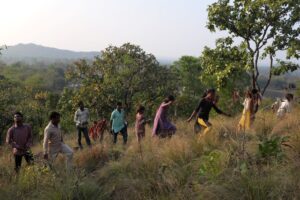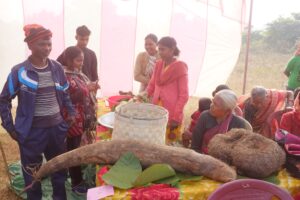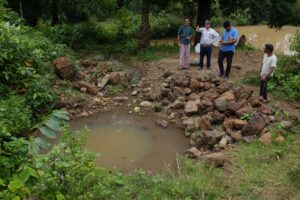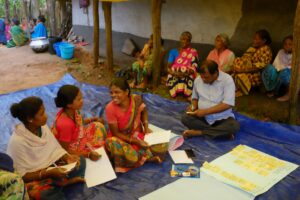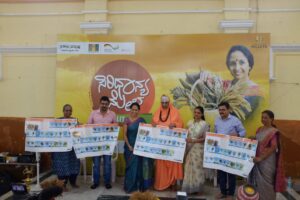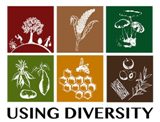Background

Litipara block is located in Pakaur district of Jharkhand and forms a part of the Sandthal Pargana division. Pakaur had been a sub-division of the Santhal Pargana District since 1868. In 1999 Pakaur received district status when Santhal Pargana was divided into four districts namely Deoghar, Godda, Sahibganj and Pakaur. Litipara is one of Pakaur District’s 6 Community Development Blocks. Litipara comprises of 308 villages (GoI Census, 2011) of which 110 are home to the Paharia PVTG community as per ground reports.
My visit to the Paharia villages of Litipara Block was facilitated by Jharkhand Vikas Parishad (JVP) a registered society working out of Amrapara. JVP was established by chief functionary Ms. Subasini Soren and has been working intensively in Pakaur district since it’s registration in 2000. JVP has been working for rural poor in the region with a special focus on women and children. Currently JVP has broadened the focus of its activities to include sustainable livelihood and agriculture promotion, Natural Resource Management, preservation and regeneration of forests and promotion of environmental protection with a focus on tribal forest dependent villages.
JVP has been working extensively in Litipara block and has developed an efficient network of community field workers and volunteers from the Paharia and Santhal communities. JVP’s current work is in tune with the objectives and goals of the UD project and they extended their support in expanding UD to Paharia villages of Litipara block.
Findings from Field Visit
6th January 2018
 I visited Makhni Pahar village along with JVP Project Officer Sanjiv Krishna Singh. Makhni Pahar comprises of 42 Paharia households. I had a meeting with women SHG members and a few other villagers which was facilitated by Kalidas Malto a village elder with considerable experience in the NGO sector and with natural resource management issues. Kalidas was being proposed as a potential UD fellow.
I visited Makhni Pahar village along with JVP Project Officer Sanjiv Krishna Singh. Makhni Pahar comprises of 42 Paharia households. I had a meeting with women SHG members and a few other villagers which was facilitated by Kalidas Malto a village elder with considerable experience in the NGO sector and with natural resource management issues. Kalidas was being proposed as a potential UD fellow.
Through the meeting I provided the villagers present a brief introduction to the UD projects objectives and goals. We discussed the status of traditional agricultural practices, the villagers dependence on uncultivated food and their forests. Awareness of FRA, 2006 and its implications with regards to the villagers’ rights to their traditional habitats was also explored.
Discussions on traditional agriculture of the Paharia’s practiced by the villagers revealed the following details:
1. Kala Kuder cultivation – Bajra, Arhar, Sutri, Kurti, Makai, Sarso sag and barbatti are the major crops grown through this form of cultivation.
In the first year Makai is grown on the land after cutting and burning of wild grass and shrubs after they are dry. In the second year Bajra and a variety of other crops are grown. The land is left fallow for 2 years before being cultivated again.
2. Dari (Jara) cultivation – Dari (known as Jara in Paharia villages of Sundar Pahari block) is carried out on hill slopes and the land is not ploughed. After clearing and burning of shrubs and grasses Barbatti is grown in the first year and then in the second year mixed crops are grown. The land is then left fallow for 4 to 5 years.
The villagers pointed out that Layo, Gunjal, Kode and Jane are some of the traditional crops that have disappeared from the area.
With regards to collection of uncultivated food some of the major UF villagers said that some common wild food included: Katchu, Kend, Ool, Jamun, Mahua, Komo sagm Kendro sag, Gandhari sag, mango, bamboo, osu (rock mushroom), Putungola (a form of fungi), crabs and fish.
The villagers stated that they look after their forests themselves though Forest Department officials come once in a while but they do not prevent them from extracting UF and NTFP.
The villagers had no awareness of FRA, 2006 and there was no FRC in the village. In fact the villagers reported that they did not currently have a functional Gram Sabha.
The meeting was followed by a short tour of the neighbouring forest area and a one on one discussion with Kalidas Malto regarding his previous experience and the possibility of his being associated with the UD project as a community fellow. Kalidas is around 70 years old, has been born and raised in Makhni Pahar village, has studied till class 10, and has worked with several NGOs including Society for advancement in Tribal Health, Education and Environment. He has considerable knowledge about traditional agriculture, forest protection and management and NTFPs. He is also adept at surveys and mapping for which is has undergone Amin training. Despite his age he was enthusiastic to cover 10 Paharia villages for the UD project.
7th January 2018
Jhamri Village
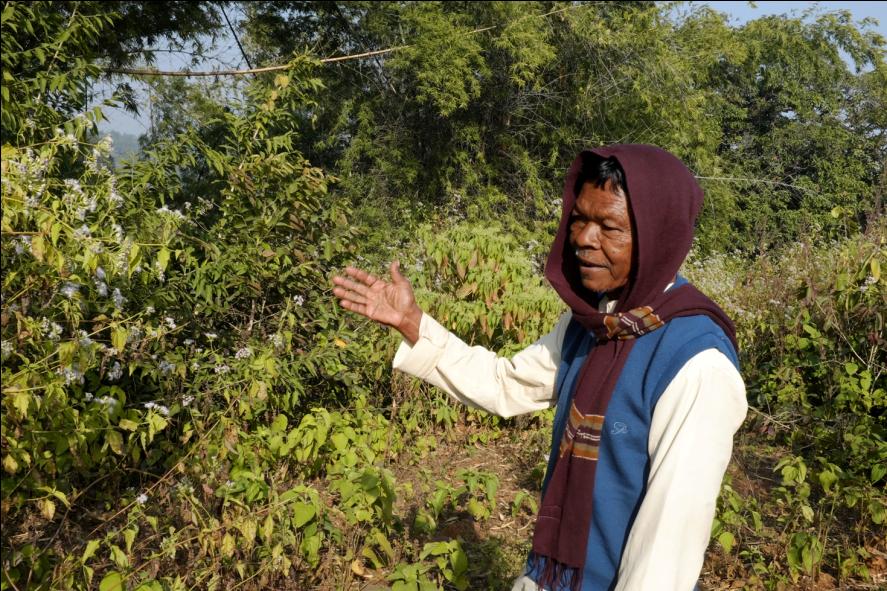
We had a meeting with a few villagers (a mix of men, women and elderly villagers) at Jhamri village. They still practice Dari cultivation on hills slope and they grow barbatti in the first year followed by bajra, lahar, sutra, makai and other crops. Uncultivated food collected by them included a variety of wild leafy vegetables like Komo saag, and others like Karko, Khangli, ber, kejri, jamun. Fish, crabs and other invertebrates from water bodies included kakdo (crab), kochli, deku. They also collect honey from tree holes, with these bees being called taini and they said the most aggressive bees were called Boiri which are most likely rock bees and they collect their honey as well from combs on large trees. Jhamri has a number of community forest areas on which they depend on for a variety of UF and other NTFPs. A brief list of neighbouring community forests is as follows:
i. Jeetra Dodh
ii. Puso Toke
iii. Jakki Kudia Dodh
iv. Ludhgadehi Dodh
v. Bedhukua Dodh
vi. Athroke Dodh
vii. Saulapur Toke
The villagers here also had no awareness of FRA and the possibility of claiming CFR or habitat rights. Just like in Makhni Pahar there was no FRC in place and the Gram Sabha was non functional.
Dusgoda Village
Dusgoda village was a more isolated interior village with good forest cover and considerable dependence on UF and NTFP. We had a meeting with 15 women who largely represent 6-7 SHGs of the village. Unlike in the other villages the women were extremely forth coming and were eager to share their thoughts and ideas. They volunteered to introduce themselves to us and were quite frank and forthcoming about their dependence on forests and uncultivated. One or two of the women said that they depended on wild vegetables and uncultivated food because they were poor and couldn’t afford to buy vegetables from the market. However, they also agreed that they received a lot of benefits from uncultivated food and were able to list several in a very short span of time –
· Fish and other creatures from water bodies – kakro, dochli (described by women as sweet and tasty), doan, eecha, meed and a variety of other fish and water creatures.
· Shrubs and plants near water bodies – tosgo, susni, kana sag, adro sag, seela sag.
· Tubers – sanjoni, haldi, pandvali, eehalee, talko, chambiya, churke, chalagen, lape aende, makree songla, marlee jage, chatlee, haorso aarostu, mako. (These tubers were listed by Reema Paharni)
The large number of UF the women and other villagers could identify in a short period of time without much prompting points to the fact that they still use their forest areas substantially and continue to collect and use a large variety of UF as a part of their regular diet. JVP staff said that a significant reason for this continued dependence on UF is the fact that Dusgoda village is a somewhat stand alone village with large patches of very good community forests. Some of the major community forest areas identified by the villagers were:
i. Tatiidani Pahadi
ii. Adhbed Dade
iii. Bamti Dade
iv. Chakkin Chapdi Dade
v. Masamo Dade
vi. Aote
vii. Arjar Pahadi
viii. Makoli Khadhi Dade
ix. Telom Pahari
x. Pokhagadha Dade
Planning and Way Forward
Kalidas Malto joined the UD project as a community fellow and he would coordinating UD activities in 10 Paharia villages of Littipara Block. He would come for an orientation program to Raiput at the end of January after which he would commence grass root activities in the selected villages. JVP agreed to support the network in coordinating and communicating with Kalidas. The initial focus in this area would be to gather baseline information on the selected villages and more detailed information on Traditional agricultural practices and uncultivated food. Awareness of FRA and its implementation is virtually nonexistent in these villages. The project would focus on gathering information of community forests and forest rights and building awareness of FRA issues.


